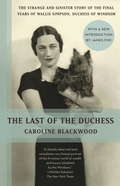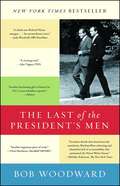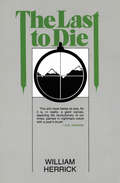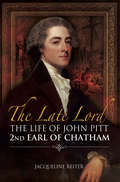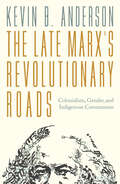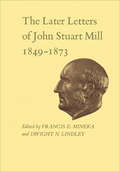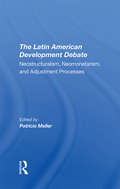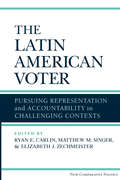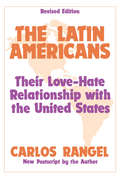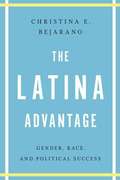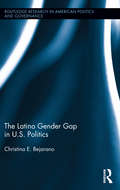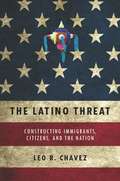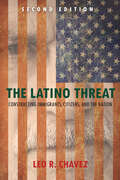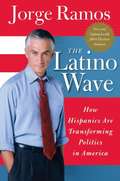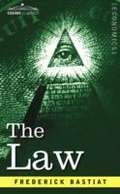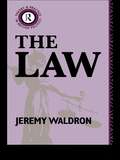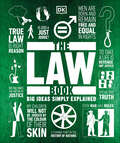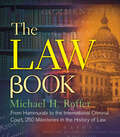- Table View
- List View
The Last of the Duchess
by James Fox Caroline BlackwoodIntriguing, suspenseful, and witty, this is the story of journalist and novelist Caroline Blackwood's search for the late Duchess of Windsor. It is also a provocative exploration of the often bizarre connection between heightened celebrity and approaching death--in Blackwood's words, "the fatal effects of myth." First serial to New York Times Magazine.
The Last of the Duchess: The Strange and Sinister Story of the Final Years of Wallis Simpson, Duchess of Windsor
by James Fox Caroline BlackwoodIntriguing, suspenseful, and witty, this is the story of journalist and novelist Caroline Blackwood's search for the late Duchess of Windsor. It is also a provocative exploration of the often bizarre connection between heightened celebrity and approaching death--in Blackwood's words, "the fatal effects of myth." First serial to New York Times Magazine.
The Last of the President's Men
by Bob WoodwardBob Woodward exposes one of the final pieces of the Richard Nixon puzzle in his new book The Last of the President’s Men. Woodward reveals the untold story of Alexander Butterfield, the Nixon aide who disclosed the secret White House taping system that changed history and led to Nixon’s resignation. In forty-six hours of interviews with Butterfield, supported by thousands of documents, many of them original and not in the presidential archives and libraries, Woodward has uncovered new dimensions of Nixon’s secrets, obsessions and deceptions. The Last of the President’s Men could not be more timely and relevant as voters question how much do we know about those who are now seeking the presidency in 2016—what really drives them, how do they really make decisions, who do they surround themselves with, and what are their true political and personal values?
The Last of the Tsars: Nicholas Ii And The Russia Revolution
by Robert ServiceA riveting account of the last eighteen months of Tsar Nicholas II's life and reign from one of the finest Russian historians writing today. In March 1917, Nicholas II, the last Tsar of All the Russias, abdicated and the dynasty that had ruled an empire for three hundred years was forced from power by revolution. Now, on the hundredth anniversary of that revolution, Robert Service, the eminent historian of Russia, examines Nicholas's life and thought from the months before his momentous abdication to his death, with his family, in Ekaterinburg in July 1918. The story has been told many times, but Service's deep understanding of the period and his forensic examination of previously untapped sources, including the Tsar's diaries and recorded conversations, as well as the testimonies of the official inquiry, shed remarkable new light on his troubled reign, also revealing the kind of Russia that Nicholas wanted to emerge from the Great War. The Last of the Tsars is a masterful study of a man who was almost entirely out of his depth, perhaps even willfully so. It is also a compelling account of the social, economic and political ferment in Russia that followed the February Revolution, the Bolshevik seizure of power in October 1917 and the beginnings of Lenin's Soviet socialist republic.
The Last to Die
by William HerrickHigh in the towering Andes, a man is on the run, being chased as much by his own raging demons as by encircling army patrols. He is Ramon Cordes, the man many consider the greatest, and perhaps last, romantic revolutionary of our time. Cordes has been betrayed. But by whom? Was it Marguerite, the only woman he has ever loved? Was it Rojos, the Party leader who shares power with no one? Or was it Ramon himself--betrayed by his doubts, by his own mocking intelligence? With the same overwhelming force and savage eloquence that characterized his great Spanish Civil War novel, Hermanos!, William Herrick involves us in the relentless hunt for Ramon Cordes. The Last to Die is a uniquely contemporary and unforgettable story of the hunted and the hunters--and the violent destiny that awaits the man who chooses to live according to his own morality.
The Late Lord: The Life of John Pitt–2nd Earl of Chatham
by Jacqueline ReiterThis biography of the second Earl of Chatham looks beyond his famous military failure to reveal one of the early nineteenth century’s most fascinating figures.John Pitt, 2nd Earl of Chatham, is one of the most enigmatic and overlooked figures of early nineteenth century British history. The elder brother of Pitt the Younger, he has long been consigned to history as the late Lord Chatham, the lazy commander-in-chief of the 1809 Walcheren expedition, whose inactivity and incompetence turned what should have been an easy victory into a disaster. In The Late Lord, Jacqueline Reiter presents a more nuanced and revealing portrait. During a twenty-year career at the heart of government, Pitt served in several important cabinet posts such as First Lord of the Admiralty and Master-General of the Ordnance. Yet despite his closeness to the Prime Minister and friendship with the Royal Family, political rivalries and private tragedy hampered his ascendance. Paradoxically for a man of widely admired diplomatic skills, his downfall owed as much to his personal insecurities and penchant for making enemies as it did to military failure.Using a variety of manuscript sources to tease Chatham from the records, this biography peels away the myths and places him for the first time in proper familial, political, and military context. It breathes life into a much-maligned member of one of Britain’s greatest political dynasties, revealing a deeply flawed man trapped in the shadow of his illustrious relatives.
The Late Marxs Revolutionary Roads: Colonialism, Gender, and Indigenous Communism
by Kevin B. AndersonThe author of the acclaimed Marx at the Margins analyses the late Marx on Indigenous communism, gender, and anti-colonialism.In his late writings, Marx went beyond the boundaries of capital and class in the Western European and North American contexts. Kevin Anderson carries out a systematic analysis of Marx&’s Ethnological Notebooks and related texts on Russia, India, Ireland, Algeria, Latin America, and ancient Rome. These texts, some of them only now being published, provide evidence for a change of perspective, away from Eurocentric worldviews or unilinear theories of development. As Anderson shows, the late Marx elaborated a truly global, multilinear theory of modern society and its revolutionary possibilities.
The Late Medieval Scottish Parliament: Politics and the three Estates, 1424–1488
by Roland TannerIn this ground-breaking study of the medieval parliament, Roland Tanner gives the Scottish Parliament a human face by examining the actions and motives of those who attended. In the past, the Scottish Parliament was seen as a weak and ineffective institution – damned because of its failure to be more like its English counterpart. But Roland Tanner shows that the old picture of weakness is far from accurate. In its very different way, the Scottish Parliament was every bit as powerful as the English institution. The ‘Three Estates’ (the clergy, nobility and burgh representatives who attended Parliament) were able to wield a surprising degree of control over the Crown during the fifteenth century. For instance, they threatened to lock James I’s taxation in a box to which he, the king, would have no access, made James II swear not to alter acts of Parliament, and prevented him from using his own lands and wealth as patronage for his supporters, and forbade James III to leave the country. Roland Tanner has avoided a dry constitutional approach. Instead he has sought to bring Parliament to life through the people who attended, the reasons why they attended, and the complex interactions which occurred when all the most wealthy, powerful and ambitious people in the kingdom gathered in one place.
The Latecomer's Rise: Policy Banks and the Globalization of China's Development Finance (Cornell Studies in Money)
by Muyang ChenIn The Latecomer's Rise, Muyang Chen reveals the nature and impact of a rapidly growing form of international lending: Chinese development finance.Over the past few decades, China has become the world's largest provider of bilateral development finance. Through its two national policy banks, the China Development Bank (CDB) and the Export-Import Bank of China (China Exim), it has funded infrastructure and industrial projects in numerous emerging markets and developing countries. Yet this very surge and magnitude of capital has raised questions about the characteristics of Chinese bilateral lending and its repercussions on the international order. Drawing on a variety of novel Chinese primary sources, including interviews and official bank documents, Chen pinpoints the distinctiveness of Chinese bilateral development finance, explains its origins, and analyzes its effects. She compares Chinese policy banks with their foreign counterparts to show that the CDB and China Exim, while state-supported, are in fact also market-oriented—they are as much government organs as they are profit-driven financial agencies that serve both state and firms' interests. This approach, which emerged out of China's particular economic history, suggests that Chinese overseas lending is not merely a tool of economic statecraft that challenges Western-led economic regimes. Instead, China's responses to extant rules, norms, and practices across given issue areas have varied between contestation and convergence.Rich with empirical detail and penetrating insights, The Latecomer's Rise demystifies the little-known workings of Chinese development finance to revise our conceptions of China's role in the international financial system.
The Later Letters of John Stuart Mill 1849-1873: Volumes XIV-XVII
by John Stuart Mill Dwight Lindley Francis MinekaThe Earlier Letters of John Stuart Mill, published in two volumes in 1963, were well received by critics and scholars alike. The publication of these four volumes of later letters completes this edition of Mill's personal correspondence. These volumes contain over 1,800 letters, most never before published, and some sixty earlier letters that have come to light since the publication of the first two volumes of correspondence. The letters have been assembled from widely dispersed collections in the libraries of fifty-eight institutions and of some thirty private collections in Britain and in other countries of the Commonwealth, Europe, and North America. In addition, many personal letters of which no originals survived have been located in contemporary periodicals or biographies of Mill's correspondence.
The Latest Illustrated Book of Development Definitions
by Carl G. LindbloomIllustrated definitions are rarely found in zoning and development ordinances. Ordinances prefer the "thousand words" rather than the "single picture." Illustrations greatly simplify how standards should be applied, particularly where the lot or parcel is irregularly shaped or where there are a number of variables present, each of which might have an impact on how the ordinance might apply in a specific situation. This best-selling resource has been the mainstay of the planner's bookshelf since its first publication and it differs from other books and publications containing development definitions in three major respects: It is illustrated; most of the definitions are designed to be used directly in ordinances with little or no change; and the more complex definitions are accompanied by commentaries and annotations that explain how the definition may be used in an ordinance, along with background information pertinent to the definition. This expanded edition standardizes in one handy reference all the key terms used in zoning, subdivision, site plan, and environmental ordinances. In all, it contains 1,957 definitions and 103 illustrations that can be incorporated in local ordinances with little or no change. Written and illustrated by two professional planners with nearly eighty years of combined experience in the practice of planning and zoning, this is a basic working tool and required reference for anyone involved in land development planning and regulation.
The Latin American Crisis and the New Authoritarian State (Routledge Studies in Latin American Development)
by Manuel LarrabureThis book provides a fresh interpretation of the rise and fall of Latin America’s ‘left turn’, or movement towards more progressive economic or social policies. From a historical and comparative perspective, the book argues that Latin America is entering a new phase of authoritarian statism. Based on over 10 years of research on Latin American political economy and social movements, including years of fieldwork in Chile, Brazil, Venezuela and Argentina, this book combines the stories of individuals and groups in particular situations with the macro-level political and economic trajectory of the region since the postwar period. The book draws on over 100 interviews with community activists, workers, union leaders, politicians, journalists, and NGOs, as well as archival work. In addition, the book uses up-to-date national and regional economic data, including both standard and heterodox development indicators. By engaging with key case studies including Argentina’s recovered enterprises, Chile’s student movement, Brazil’s free transit movement, and Venezuela’s popular economy, this book analyzes the complex relationship between "post-capitalist struggles" and the governance models of the "pink tide", the wave of left governments that began to sweep the region at the turn of the century. This book will be of interest to researchers across politics, development, Latin American studies and social movement studies. The original data and analysis of the relationship between social movements and governments will also benefit policymakers and those working within the NGO sector.
The Latin American Development Debate: Neostructuralism, Neomonetarism, And Adjustment Processes
by Patricio MellerIn the 1980s Latin America experienced its second worst economic crisis of the century; today the average per capita income is about 10 percent less than a decade ago. Because the crisis affected all Latin American countries regardless of their economic policies, the period has become known as "the lost decade in Latin America." In this book, eminent economists from the region reexamine strategies of development—structuralism versus monetarism, liberalism versus statism, growth versus equity—in light of new theoretical knowledge and recent economic events. The essays offer a complex interpretation of development problems and seek to explain how different schools of thought could be compatible and how old debates must be recast in the light of structural changes in Latin American economies. In addition, contributors critically review the adjustment processes applied in various countries. Together the chapters offer a penetrating analysis of what went wrong in Latin America in the 1980s and a careful assessment of economic measures and policies that might prove viable in promoting stable and growing economies, democratic regimes, and social justice.
The Latin American Voter: Pursuing Representation And Accountability In Challenging Contexts
by Ryan E. Carlin Matthew M. Singer Elizabeth J. ZechmeisterIn this volume, experts on Latin American public opinion and political behavior employ region-wide public opinion studies, elite surveys, experiments, and advanced statistical methods to reach several key conclusions about voting behavior in the region's emerging democracies. In Latin America, to varying degrees the average voter grounds his or her decision in factors identified in classic models of voter choice. Individuals are motivated to go to the polls and select elected officials on the basis of class, religion, gender, ethnicity and other demographic factors; substantive political connections including partisanship, left-right stances, and policy preferences; and politician performance in areas like the economy, corruption, and crime. Yet evidence from Latin America shows that the determinants of voter choice cannot be properly understood without reference to context--the substance (specific cleavages, campaigns, performance) and the structure (fragmentation and polarization) that characterize the political environment. Voting behavior reflects the relative youth and fluidity of the region's party systems, as parties emerge and splinter to a far greater degree than in long-standing party systems. Consequently, explanations of voter choice centered around country differences stand on equal footing to explanations focused on individual-level factors.
The Latin Americans: Their Love-hate Relationship with the United States
by Carlos RangelThis is a provocative work that runs counter to the conventional wisdom that the poor are poor because the rich are rich. Rangel argues that the reasons for different levels of economic development between North America and Latin America lie in the two continents' divergent history of colonization, the differences between their dominating social structures, and the contrary ethical precepts of Catholicism and Protestantism. Last, but by no means least, there are two all-pervasive myths: in the past, that of the noble savage, in the present, that of the good revolutionary.
The Latina Advantage: Gender, Race, and Political Success
by Christina E. BejaranoDuring the past decade, racial/ethnic minority women have made significant strides in U. S. politics, comprising large portions of their respective minority delegations both in Congress and in state legislatures. This trend has been particularly evident in the growing political presence of Latinas, yet scholars have offered no clear explanations for this electoral phenomenon--until now. In The Latina Advantage, Christina E. Bejarano draws on national public opinion datasets and a close examination of state legislative candidates in Texas and California to demonstrate the new power of the political intersection between race and gender. Underscoring the fact that racial/ethnic minority women form a greater share of minority representatives than do white women among white elected officials, Bejarano provides empirical evidence to substantiate previous theoretical predictions of the strategic advantage in the intersectionality of gender and ethnicity in Latinas. Her evidence indicates that two factors provide the basis for the advantage: increasingly qualified candidates and the softening of perceived racial threat, leading minority female candidates to encounter fewer disadvantages than their male counterparts. Overturning the findings of classic literature that reinforce stereotypes and describe minority female political candidates as being at a compounded electoral disadvantage, Bejarano brings a crucial new perspective to dialogues about the rapidly shifting face of America's electorate.
The Latino Century: How America's Largest Minority Is Transforming Democracy
by Mike MadridAn insightful investigation of how and why the two major political parties have failed to appeal to the Latino vote—the largest ethnic voting group in the country—and the impact it will have on American democracy and politics for decades to come.In 2020, Latinos became the second largest ethnic voting group in the country. They make up the largest plurality of residents in the most populous states in the union, as well as the fastest segment of the most important swing states in the US Electoral College. Fitting neither the stereotype of the aggrieved minority voter nor the traditional assimilating immigrant group, Latinos are challenging both political parties' notions of race, religious beliefs, economic success, and the American dream. Given their exploding numbers—and their growing ability to determine the fate of local, state, and national elections—you&’d think the two major political parties would understand Latino voters. After all, their emergence on the national scene is not a new phenomenon. But they still don&’t. Republicans, not because of their best efforts but rather despite them, are just beginning to see a movement of Latinos toward the GOP. Democrats, for the moment, still win a commanding share of the Latino vote, but that share is dwindling fast. Now, in The Latino Century, veteran political consultant Mike Madrid uses thirty years of research and campaign experience at some of the highest levels on both sides of the aisle to address what might be the most critical questions of our time: Will the rise of Latino voters continue to foment the hyper-partisan and explosive tribalism of our age or will they usher in a new pluralism that advances the arc of social progress? How and why are both political parties so uniquely unprepared for the coming wave of Latino votes? And what must each party do to win those votes? By answering these questions, The Latino Century explores the true meaning of America at a time of rapid cultural change, the founding principles of self-government and individual responsibility, and one man&’s journey through a political party that has turned itself inside out.
The Latino Gender Gap in U.S. Politics (Routledge Research in American Politics and Governance)
by Christina E. BejaranoMany questions remain unanswered about the observable differences in voting behavior, partisanship, and cultural attitudes among men and women. Latino political participation in the United States is generally lower than the rest of the population, mainly due to their high proportion of youth and foreign born populations that are ineligible to vote. This dynamic is slowing changing, partly as a result of the rapidly growing Latino population in the United States. This book delves deeper into the complex gender differences for Latino political behavior. More specifically, it is a political analysis of the diverse U.S. Latino population and the interacting factors that can influence male and female differences in voting and policy attitudes. Christina E. Bejarano carefully unpacks more aspects of the gender category for Latinos, including analyzing the gender differences in Latino political behavior across national origin, foreign born status, and generational status. The Latino gender gap can have far-reaching political implications on electoral politics. As the Latino population highlights their growing political sway, the major political parties have and will strategically mobilize and court the Latino electorate, Latinas in particular.
The Latino Threat: Constructing Immigrants, Citizens, and the Nation
by Leo ChavezThe April 2005 Minuteman Project, in which vigilantes from the US patrolled the border with Mexico, and the mass rallies of Latinos in many US cities during the spring of 2006, says Chavez (anthropology, U. of California-Irvine), were both elements in an ongoing debate about immigration, the meaning of citizenship, and the power of media spectacles. He discovers a narrative that Latinos, unlike previous immigrants, are unwilling or incapable of integrating into US life, and are devoted to reconquering the southwest of the country that was stolen from them and destroying the American way of life.
The Latino Threat: Second Edition
by Leo R. ChavezNews media and pundits too frequently perpetuate the notion that Latinos, particularly Mexicans, are an invading force bent on reconquering land once their own and destroying the American way of life. In this book, Leo R. Chavez contests this assumption's basic tenets, offering facts to counter the many fictions about the "Latino threat." With new discussion about anchor babies, the DREAM Act, and recent anti-immigrant legislation in Arizona and other states, this expanded second edition critically investigates the stories about recent immigrants to show how prejudices are used to malign an entire population—and to define what it means to be American.
The Latino Wave
by Jorge RamosEn las elecciones del 2004, hubo 3 millones más votantes hispanos que en el año 2000. Los hispanos pusieron al presidente George W. Bush en la Casa Blanca en el 2000 y luego lo reeligieron en el 2004. Es imposible ignorar una influencia tan grande y un voto tan importante. El cambio más dramático que está viviendo este país no tiene nada que ver con la guerra contra el terrorismo o con la economía; tiene que ver, simplemente, con la revolución demográfi ca impulsada por los latinos. Es la Ola Latina. En el 2002 los latinos se convirtieron, ofi cialmente, en el grupo minoritario más grande de Estados Unidos, superando los 38 millones de habitantes, cosa que no se esperaba que ocurriera hasta dentro de una década más. Para el año 2125 habrá más latinos que blancos (no hispanos) en Estados Unidos. Es decir, los hispanos pasarán de minoría a mayoría. Basándose en entrevistas con los más reconocidos expertos en temas latinos y con hispanos que viven a lo largo y ancho de los Estados Unidos, Ramos intenta descifrar lo que signifi ca este sorprendente cambio demográfi co para todos los norteamericanos, hispanos o no, tanto en su vida diaria como en su cultura. Con el profesionalismo, precisión, y sensibilidad que lo caracteriza, Ramos nos muestra quienes son, exactamente, estos nuevos americanos, cuáles son sus intereses políticos y por qué es importante que el resto del país se preocupe por entender lo que es la "experiencia latina". Quien ignore el reto de los latinos, corre el riesgo de darle la espalda al futuro de Estados Unidos.
The Law
by Frederick BastiatFrench political libertarian and economist, Frederick Bastiat was one of the most eloquent champions of the concept that property rights and individual freedoms flowed from natural law. Here, in this 1850 classic, a powerful refutation of Karl Marx's Communist Manifesto, Bastiat discusses: what is law?
The Law (Theory and Practice in British Politics)
by Jeremy WaldronFirst published in 1990. Routledge is an imprint of Taylor & Francis, an informa company.
The Law Book (DK Big Ideas)
by DKLearn about the most important legal milestones in history in The Law Book.Part of the fascinating Big Ideas series, this book tackles tricky topics and themes in a simple and easy to follow format. Learn about Law in this overview guide to the subject, great for novices looking to find out more and experts wishing to refresh their knowledge alike! The Law Book brings a fresh and vibrant take on the topic through eye-catching graphics and diagrams to immerse yourself in. This captivating book will broaden your understanding of Law, with:- More than 90 ground-breaking legal milestones- Packed with facts, charts, timelines and graphs to help explain core concepts- A visual approach to big subjects with striking illustrations and graphics throughout- Easy to follow text makes topics accessible for people at any level of understandingThe Law Book is a captivating introduction to the legal precedents, and religious, political, and moral codes that have shaped the world we live in, aimed at adults with an interest in the subject and students wanting to gain more of an overview. Discover the most important milestones in legal history, from the Code of Hammurabi to groundbreaking legislation including Magna Carta and the Abolition of the Slave Trade Act, all through exciting text and bold graphics.Your Law Questions, Simply ExplainedThis engaging overview goes into legal history across the world, all the way into the 21st century, with copyright in the digital age, same-sex marriage, and the &“right to be forgotten&”. If you thought it was difficult to learn about legislations and legal history, The Law Book presents key information in an easy to follow layout. Learn about the most important breakthroughs, like the fight for universal suffrage and workers&’ rights, and the establishment of international legal bodies like INTERPOL and the European Court of Justice.The Big Ideas SeriesWith millions of copies sold worldwide, The Law Book is part of the award-winning Big Ideas series from DK. The series uses striking graphics along with engaging writing, making big topics easy to understand.
The Law Book: From Hammurabi to the International Criminal Court, 250 Milestones in the History of Law (Union Square & Co. Milestones)
by Michael H. RofferWhich was the last country to abolish slavery?Which is the only amendment to the U.S. Constitution ever to be repealed?How did King Henry II of England provide a procedural blueprint for criminal law? These are just a few of the thought-provoking questions addressed in this beautifully illustrated book. Join author Michael H. Roffer as he explores 250 of the most fundamental, far-reaching, and often-controversial cases, laws, and trials that have profoundly changed our world—for good or bad. Offering authoritative context to ancient documents as well as today&’s hot-button issues, The Law Book presents a comprehensive look at the rules by which we live our lives. It covers such diverse topics as the Code of Hammurabi, the Ten Commandments, the Trial of Socrates, the Bill of Rights, women&’s suffrage, the insanity defense, and more. Roffer takes us around the globe to ancient Rome and medieval England before transporting us forward to contemporary accounts that tackle everything from civil rights, surrogacy, and assisted suicide to the 2000 U.S. presidential election, Google Books, and the fight for marriage equality. Organized chronologically, the entries each consist of a short essay and a stunning full-color image, while the &“Notes and Further Reading&” section provides resources for more in-depth study. Justice may be blind, but this collection brings the rich history of the law to light.
